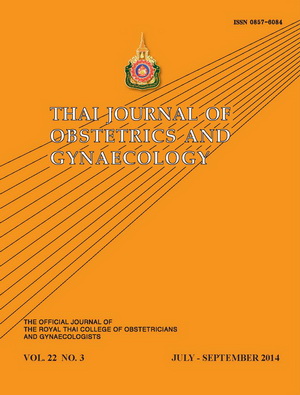Prevalence, Associated Factors and Pregnancy Outcomes of Anemia during Intrapartum Period in HIV-Infected Pregnant Women
Main Article Content
Abstract
Objective: To determine prevalence, associated factors and pregnancy outcomes of anemia during intrapartum period in HIV-infected pregnant women.
Materials and Methods: A prospective and descriptive study was conducted at the Department of Obstetrics and Gynecology, Faculty of Medicine Siriraj Hospital,MahidolUniversity,Bangkok,Thailand from September 2011 to July 2013. One hundred and five HIV-Infected pregnant women during intrapartum period were included into the present study.
Results: The prevalence of anemia at intrapartum period was 41.0% (95% confidence interval = 32.0-50.5). Compared with normal group, anemia group had a higher rate of no antenatal care (ANC), anemia at first ANC, viral load ≥400 copies/ml and positive urine amphetamine. In addition, a lower mean age and a lower rate of known case of HIV infection before current pregnancy were found in anemia group. By multiple logistic regression analysis, anemia at first ANC and viral load ≥400 copies/ml were only two parameters that associated with anemia at delivery (p = 0.003, OR = 1.64, 95% CI = 1.16 – 2.23 and p = 0.000, OR = 4.5, 95% CI = 1.28 – 15.89, respectively). Regarding to pregnancy outcomes, the patients in anemia group had a higher rate of preterm birth, low birth weight and blood transfusion than the other group.
Conclusion: With two associated factors, anemia at first ANC and viral load ≥400 copies/ml, a high prevalence of anemia at delivery in HIV-infected pregnant women was found in the present study. Compared with normal group, the pregnancy outcomes in anemia group seem to be poorer. However, these conclusions should be interpreted in light of limitation of the number of patients in this study.

